Sony Group PCG1J1L Handheld PC with wireless radios User Manual SmartWi Connection Utility Guide
Sony Corporation Handheld PC with wireless radios SmartWi Connection Utility Guide
Contents
Connect Bluetooth

Personal Computer
SmartWi Connection Utility
Guide
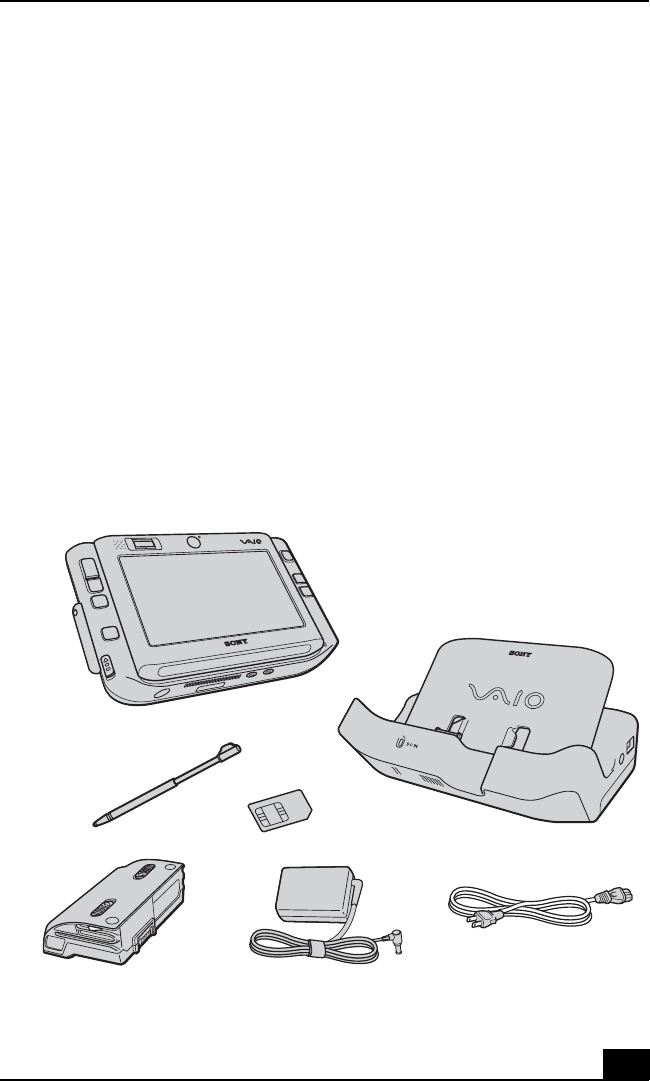
About your Computer
1
About your Computer
Thank you for purchasing a VAIO® computer! Your new machine
combines state-of-the-art hardware and software to bring you
unparalleled wireless connectivity.
Contents
Your computer may not be equipped with all of these hardware features or
accessories. The location of the controls, ports, and jacks may vary from the
illustrations shown in this section. See your computer’s specification sheet for
details on your computer’s supplied accessories.
* A Cingular SIM card is preinstalled in your computer.
** Located on the back of the unit. Slide up and pull out for touch panel operations.
*** Remove the cover to access the SIM card slot.
Carton Contents
Computer
SIM card*
Power cord
Battery AC adapter
Stylus**
SIM card
slot
cover*** Cradle
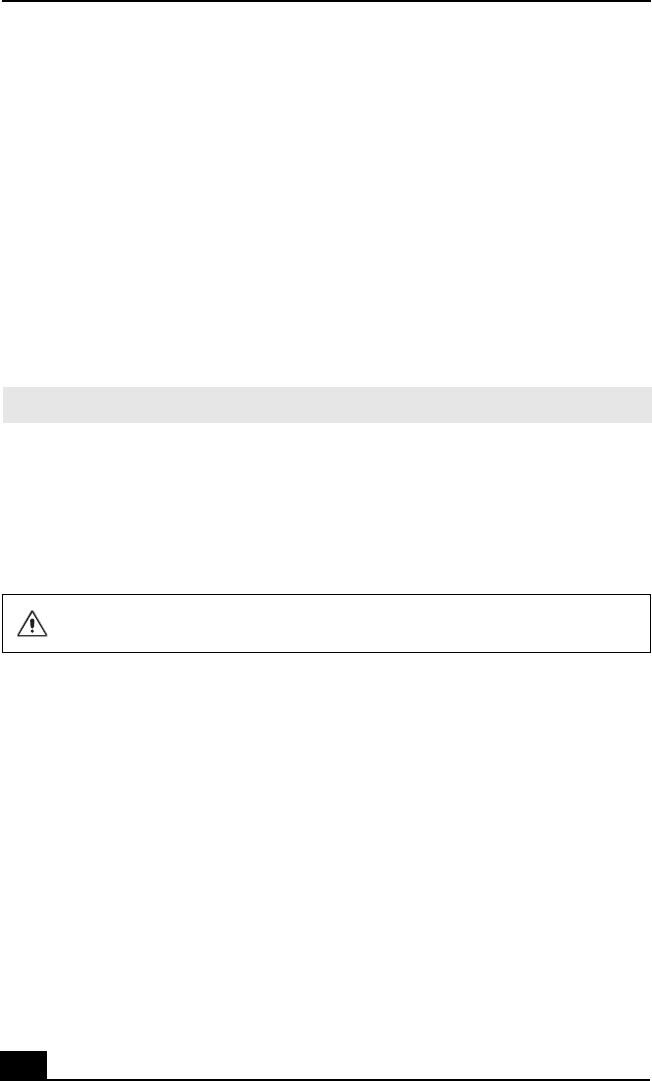
VAIO® Computer Wireless Information
2
About Wireless Connectivity
With built-in Wireless WAN capabilities, your computer is equipped to connect
wirelessly to your e-mail, the Internet, and any intranet networks with which you
may be associated.
About the Cingular SIM Card
The SIM card, provided by Cingular Wireless, is a small printed circuit board
that stores data identifying the user to the network service provider. It must be
inserted into the computer for you to make use of the Wireless WAN wireless
services.
Inserting the Cingular SIM card
The Cingular SIM card should be preinstalled; you may follow these procedures
to verify that the SIM card is indeed installed in the SIM card slot located under
the SIM card slot cover on the left side of your computer.
✍ Only the Cingular SIM card is supported. It is normally preinstalled in your computer.
Do not touch the SIM card connectors. As a precaution, always make sure you
have a firm hold of your computer before inserting or removing the SIM card.
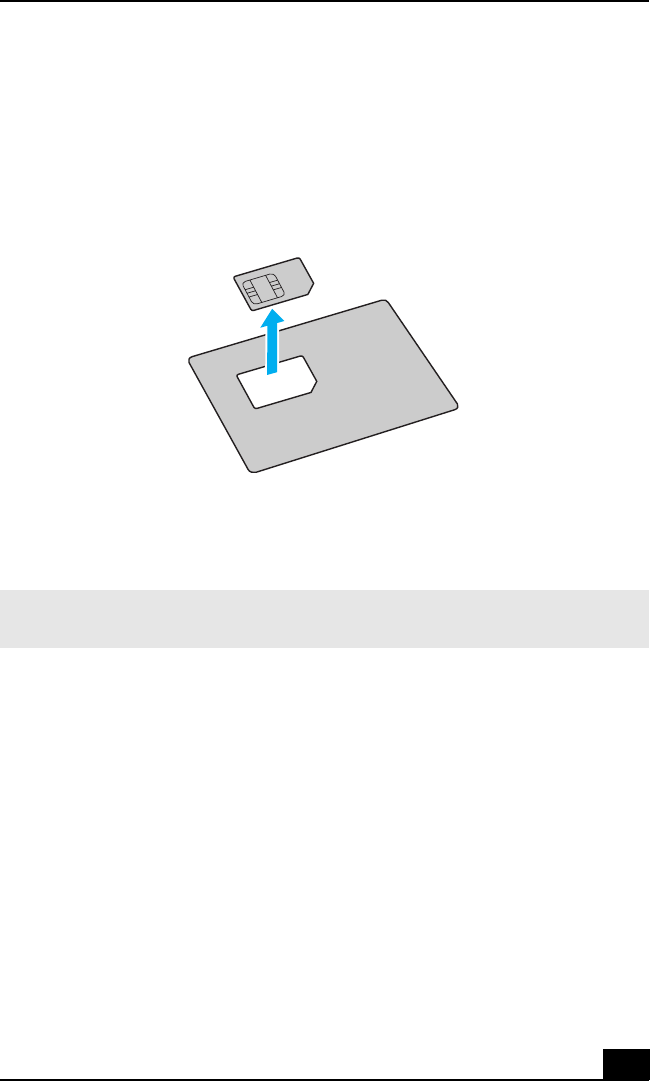
About the Cingular SIM Card
3
1Unless preinstalled, your SIM card is contained within a larger card, about
the size of a credit card. Remove the smaller SIM card by pushing it out
from the larger card.
2Next, orient your computer so you are facing its left side.
3Locate the SIM card slot under the SIM card slot cover on the left side of the
computer and with its printed circuit side facing down, gently insert the SIM
card into the slot. Check the SIM card for directions on which way to orient
the card into the slot.
Cingular SIM Card
✍Before inserting the SIM card into the computer, make sure your computer is turned
off and the battery is not attached.
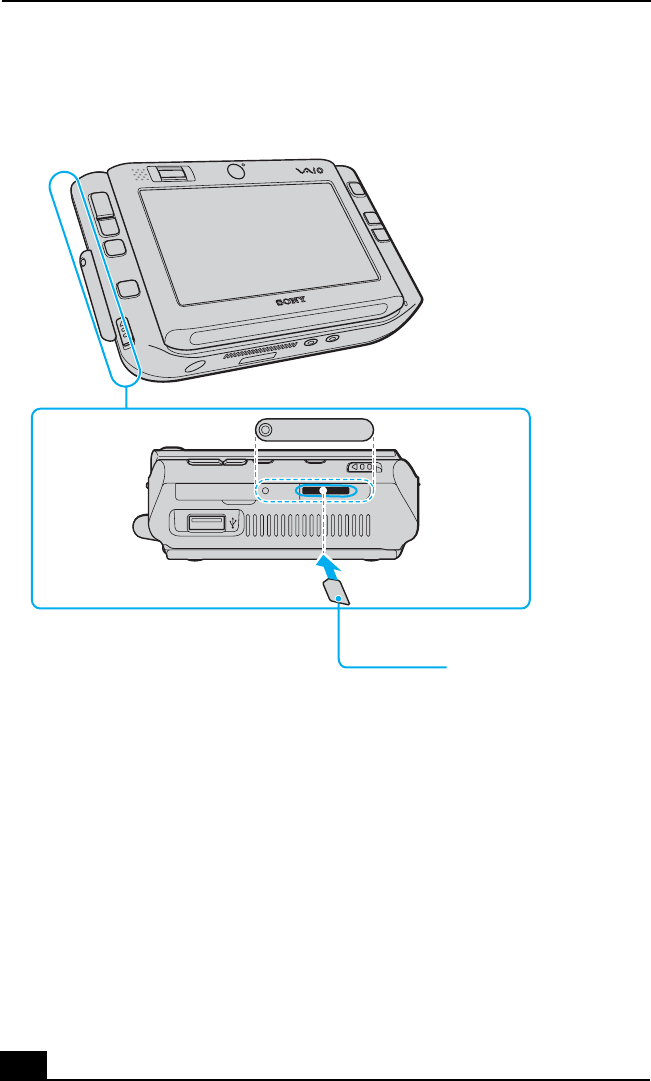
VAIO® Computer Wireless Information
4
If your computer came with a preinstalled Cingular SIM card, verify that the card
is indeed in the SIM card slot.
If a SIM card can not be found in the unit, there are two ways to obtain the card:
1Contact Sony’s VAIO PC support line (888)-476-6972 and request a free
replacement SIM card. Please note that you must have the VAIO product
model number and serial number to receive the replacement SIM from Sony.
Subject to availability, the replacement SIM card will be shipped from Sony
to you without charge.
2Go to the local Cingular store and ask for SIM card for local service.
Additional cost would apply in this process.
Inserting the SIM card
Cut-off corner
oriented left
SIM card
(printed circuit face down)
SIM card slot cover
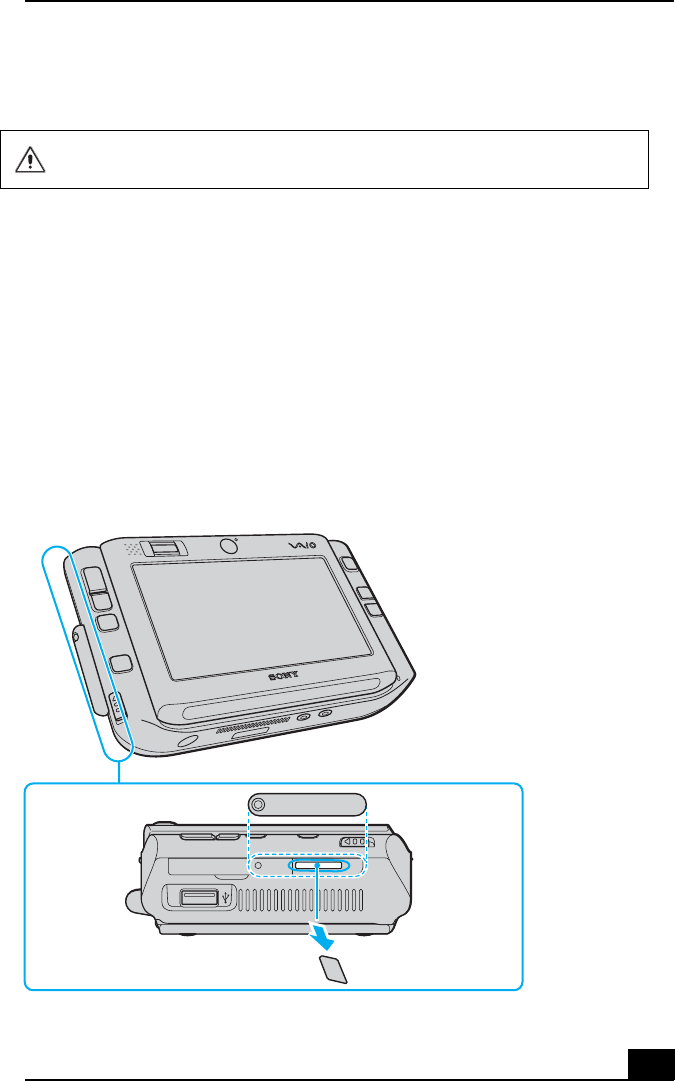
About the Cingular SIM Card
5
Removing the SIM Card
To remove the SIM card, again orient your computer so you are facing its left
side. Make sure the computer is turned off.
1Locate the SIM card slot cover on the left side of your computer.
2Carefully unscrew the screw located on the left of the cover and remove the
cover.
3Gently push in the SIM card until you hear it click, then release the card
allowing the SIM card to eject. After the SIM card ejects, gently pull the
card out of the slot, away from the computer.
Do not touch the SIM card connectors. As a precaution, make sure you have a
firm hold of your computer before inserting or removing the SIM card.
Removing the SIM Card
SIM card slot cover

VAIO® Computer Wireless Information
6
✍Take care not to damage the card in any way, either by bending or putting undue
pressure on the card.
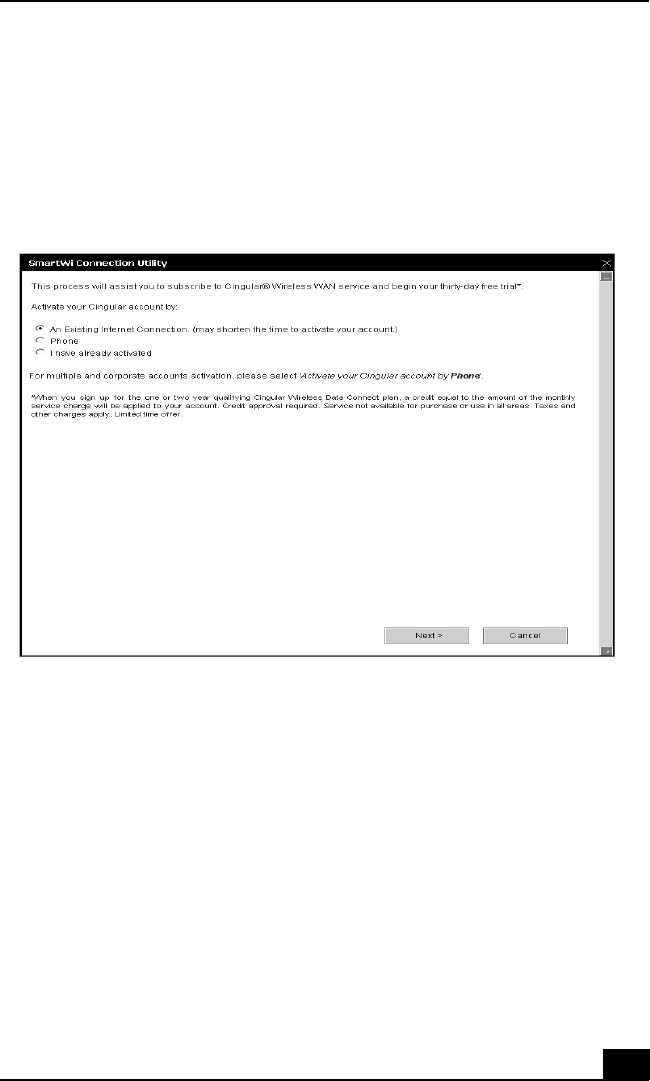
To activate your Cingular account
7
To activate your Cingular account
Follow the activation wizard to activate your Cingular account.You can also
check the status on your activation by following the activation status wizard.
Activation screen
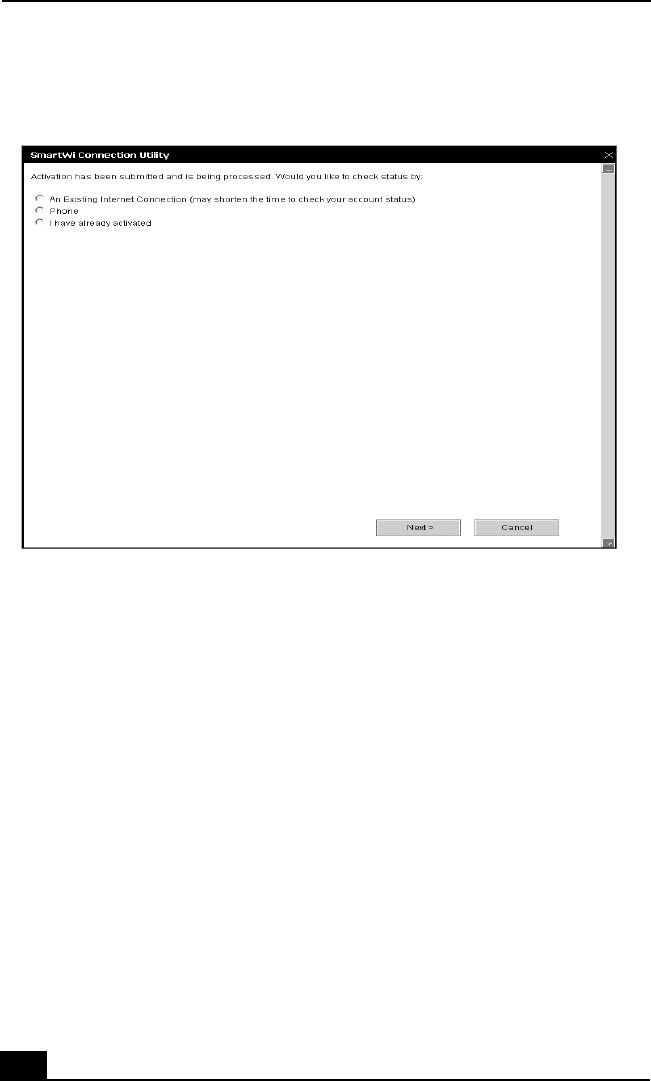
VAIO® Computer Wireless Information
8
Activation status screen
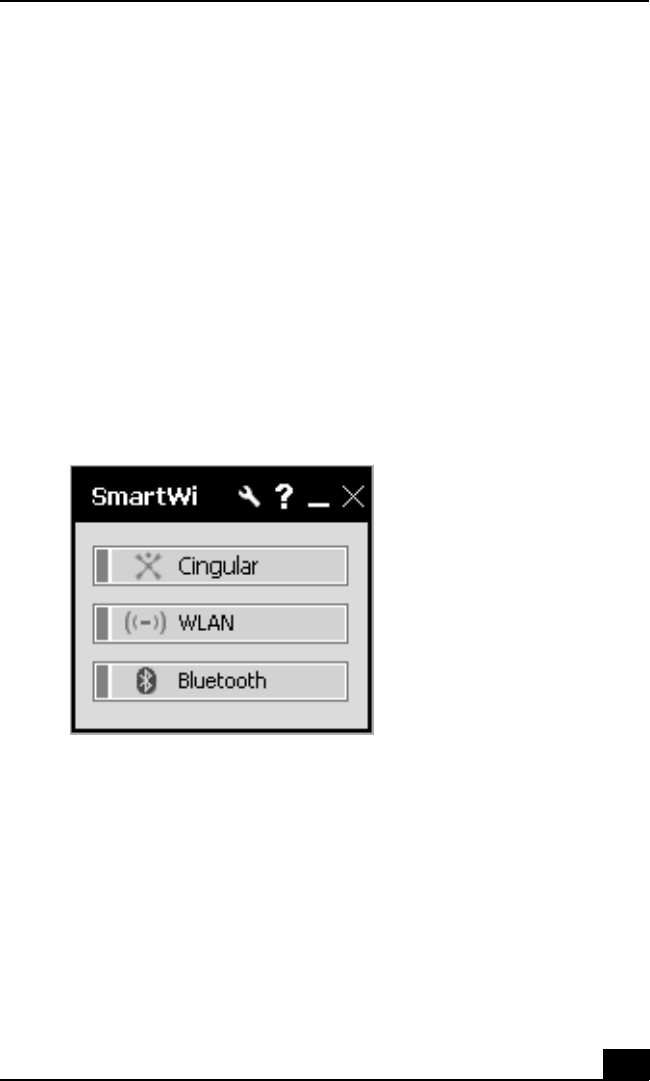
About SmartWi Connection Utility
9
About SmartWi Connection
Utility
The SmartWi Connection Utility functions largely as a switch manager between
the various forms of wireless connectivity: Bluetooth®, WLAN, and WWAN
using Cingular Wireless software.
By clicking on each of the three wireless options, the SmartWi Connection
Utility switches to the corresponding one.
Starting SmartWi Connection Utility
At initial startup, a pop-up prompt appears from the Task Tray. Clicking on the
pop-up prompt or double clicking on the tool icon launches the SmartWi
Connection Utility, then you are prompted to activate your Cingular account.
If you close the program, however, and later wish to restart it, do the following:
SmartWi Connection Utility main screen
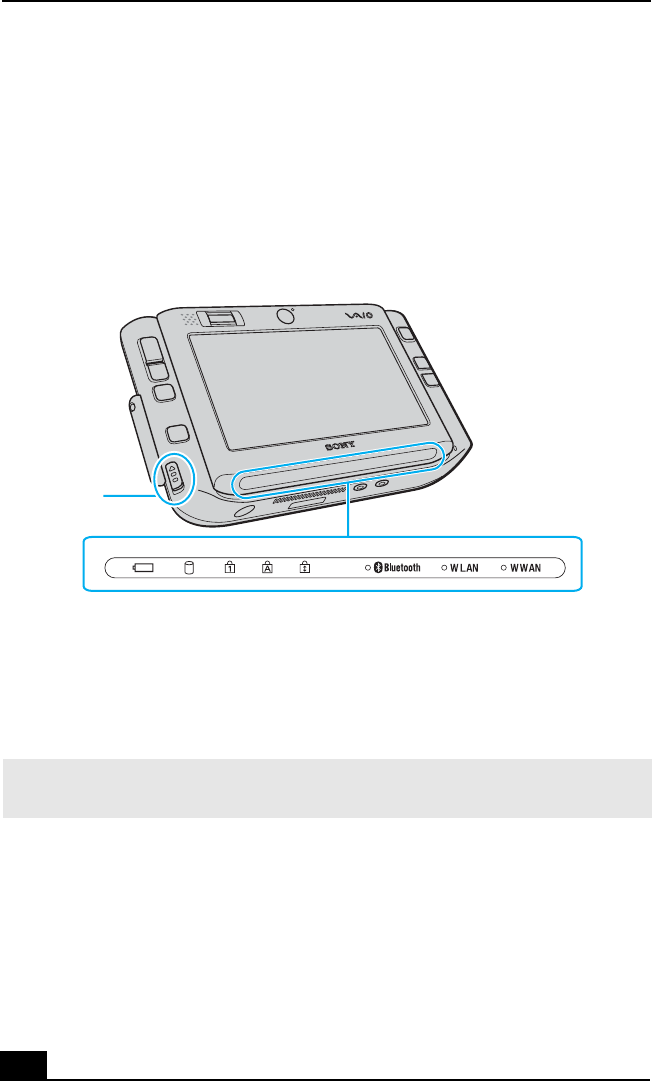
VAIO® Computer Wireless Information
10
1First make sure your computer is turned on.
2Make sure the wireless switch is turned on. If it is not, locate the switch on
the front left portion of your computer and slide the switch up to the ON
position.
3You may also click the SmartWi Connection Utility icon in the taskbar
notification area. Depending on the wireless selection, one of six icons may
appear in the taskbar notification area.
Wireless switch and indicators
✍Once you turn on the wireless switch, the SmartWi Connection Utility window appears
automatically.
W
ireless
S
witch

Starting SmartWi Connection Utility
11
4Alternately, press Start, select All Programs, select the VAIO SmartWi
Connection Utility folder, and click SmartWi Connection Utility. The
SmartWi Connection Utility dialog box displays.
SmartWi Connection Utility icons
✍Note that WWAN and WLAN cannot coexist simultaneously. When one is selected, the
other is automatically deselected.
Bluetooth
Wireless device is turned off (no WWAN or WLAN)
WLAN
WWAN
WWAN and Bluetooth
WLAN and Bluetooth

VAIO® Computer Wireless Information
12
About the Wireless Switching
Window
The Wireless Switching Window is another utility that enables switching
between wireless modes. It promotes ease of use by allowing you to switch
between Bluetooth®, WLAN, and WWAN simply by pressing keyboard buttons
instead of using the touch pad (or a separately available USB mouse).
Using the Wireless Switching Window
To start the Wireless Switching Window in order to switch between wireless
modes, simply press Fn + F to bring up the window. Then hold the Fn key down
while pressing the F key to toggle between modes.
Wireless Switching Window
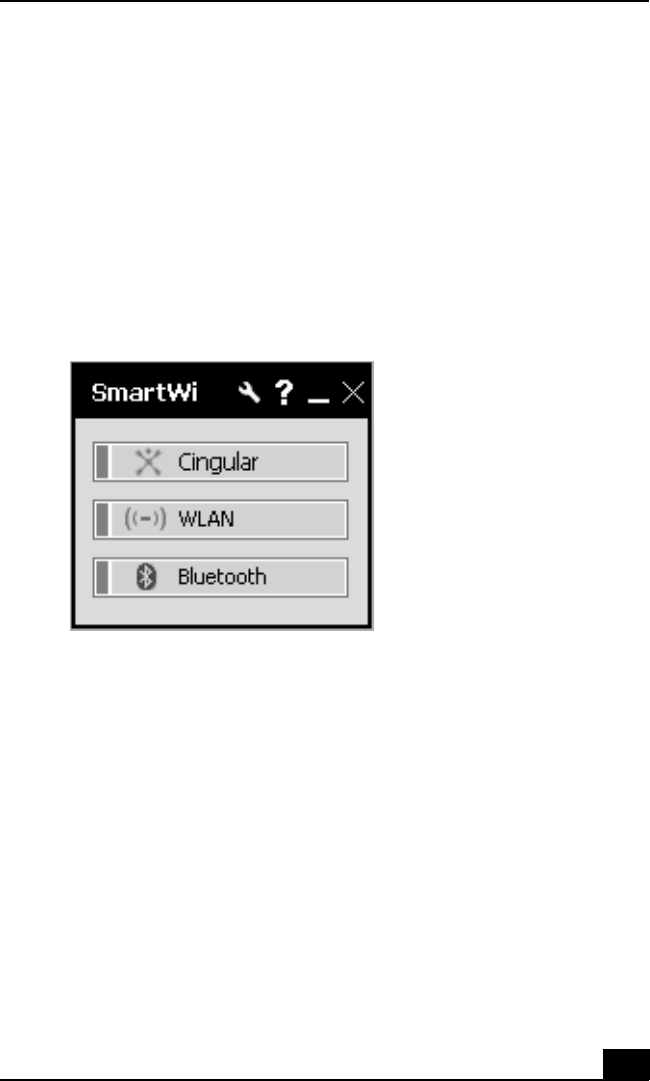
Using Wireless Connection Utility
13
Using Wireless Connection Utility
To use the wireless connectivity features and begin using e-mail or connecting to
the Internet, simply click the desired button: Cingular Wireless (for WAN
connectivity), WLAN, or Bluetooth®.
Wireless Connection Utility main screen
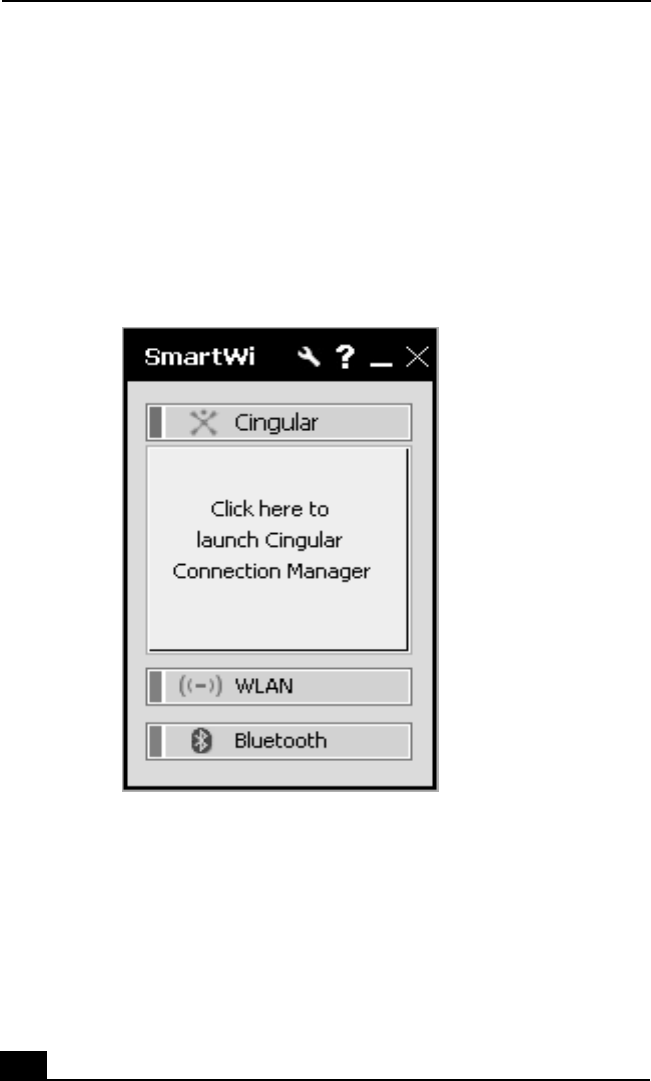
VAIO® Computer Wireless Information
14
Using the Cingular Wireless WAN connection
To use Cingular WAN connectivity, do the following:
1Click the Cingular button on the SmartWi Connection Utility main screen.
A Cingular Connection Manager launch area display appears below the
button.
2Click anywhere in the Cingular Connection Manager launch area.
The Cingular Connection Manager window displays.
Cingular Connection Manager launch area
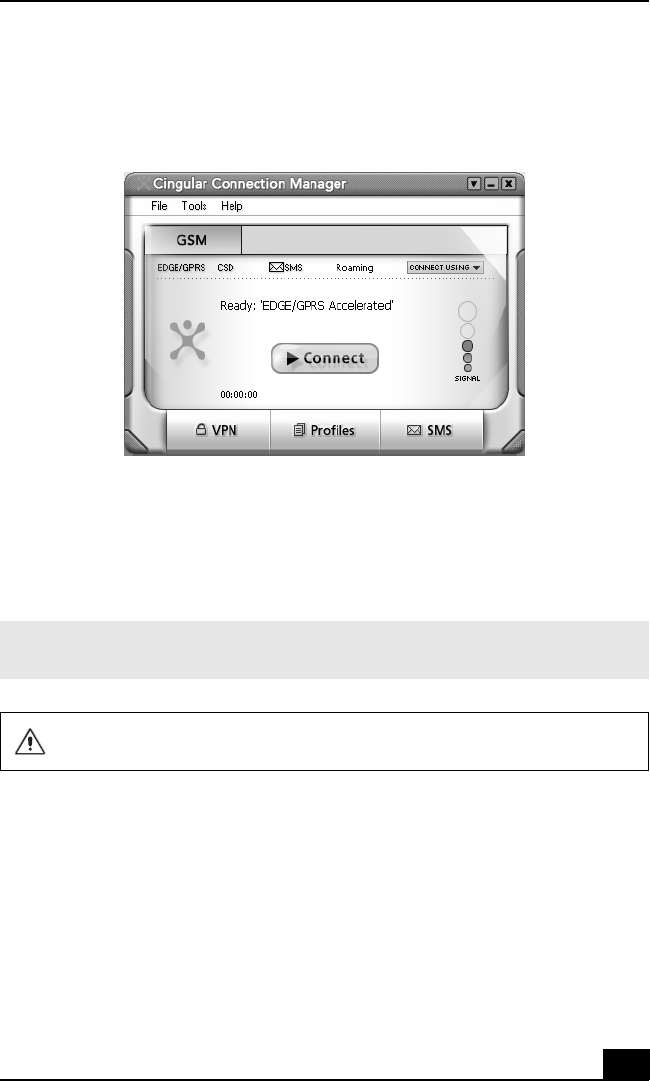
Using the Cingular Wireless WAN connection
15
3By default, your connection to Cingular service initiates.
4Follow any additional directions on the Cingular Connection Manager
window display.
Cingular Connection Manager main screen
✍For help, click the Help drop-down menu and click Help to display the Cingular
Connection Manager help file.
For FCC Radio Frequency Exposure (RF) safety reasons, please ensure to keep
the device 20cm distance from the body when WWAN is operating.
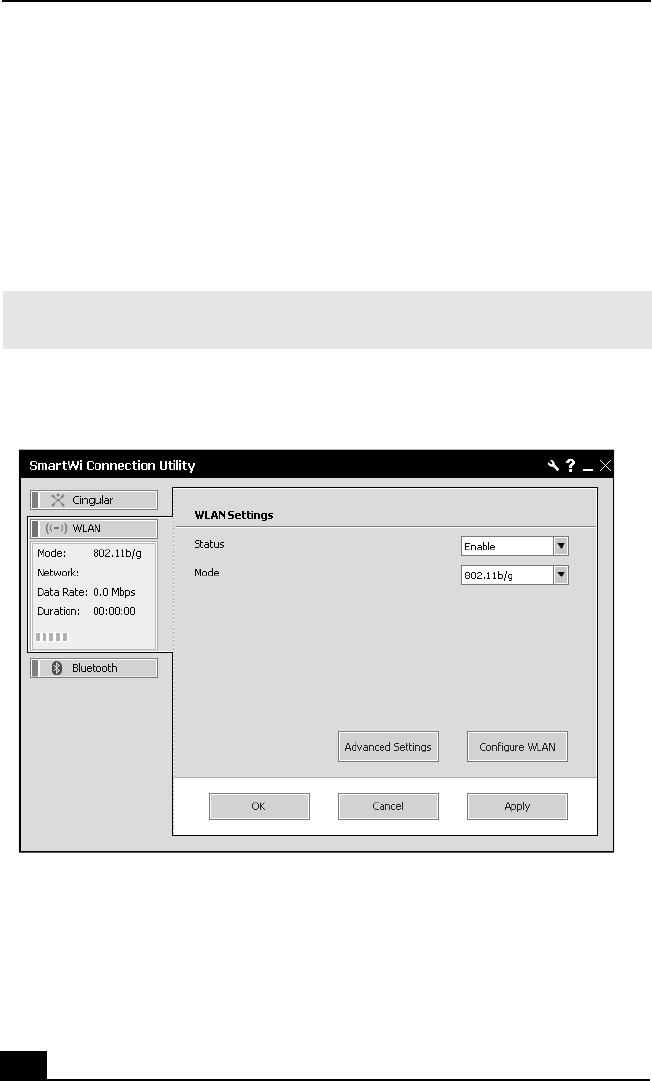
VAIO® Computer Wireless Information
16
Using the Wireless LAN connection
To use Wireless LAN (WLAN) connectivity, do the following:
1Click the WLAN button on the SmartWi Connection Utility main window.
A status display appears below the button.
2Next, click the status display below the WLAN button. The window
enlarges to display WLAN Settings.
To deactivate WLAN connectivity, select Disable for the Status field drop-down
box on the WLAN Settings dialog.
✍If it is the first time connect with WLAN, the Wireless Help Utility will launch
automatically and guide you during initial setup.
WLAN Settings dialog box

Using the Wireless LAN connection
17
By default, WLAN uses theIEEE802.11a/b/g standard technology for WLAN
connectivity. The standard includes the Wired Equivalent Privacy (WEP) encryption
method, which is a security protocol and WiFi Protected Access.
To use IEEE802.11b or IEEE802.11g WLAN connectivity standard only, select
them from the Mode field drop-down box.
Configuring the WLAN connection
You can configure your computer to connect to a WLAN using one of the
following ways:
❑without an access point device (ad-hoc)
❑with an access point device
An ad-hoc network is a network in which a local network is created only by the
wireless devices themselves, with no other central controller or access point
device. Each device communicates directly with other devices in the network.
For example, you can set up an ad-hoc network easily at home to communicate
between two computers.
A computer communicating with an access point device is configured as part of
an infrastructure network. An infrastructure network is a network that extends an
existing wired local network to wireless devices by providing an Access Point,
✍Wireless LAN devices using the IEEE802.11a standard and the ones using the
IEEE802.11b or g standard cannot communicate because the frequencies are
different. Wireless LAN devices using the IEEE802.11g standard can only
communicate with a device using the IEEE802.11b/g standard, not with the
IEEE802.11a standard.
✍IEEE802.11a: The standard speed is 54 Mbps, or about 5 times faster than a Wireless
LAN device using the IEEE802.11b standard. The IEEE802.11a connection is only
available on certain computer models.
✍IEEE802.11b: The standard speed is 11 Mbps, or about 30 to 100 times faster than a
standard dial up.
✍IEEE802.11g: The standard speed is 54 Mbps, or about 5 times faster than a Wireless
LAN device using the IEEE802.11b standard.

VAIO® Computer Wireless Information
18
for example the Sony Access Point. The Access Point bridges the wireless and
wired LAN and acts as a central controller for the Wireless LAN. The Access
Point coordinates transmission and reception from multiple wireless devices
within a specific range.
❑To configure your computer to communicate without an access point device
(ad-hoc), follow these steps:
1On the WLAN Settings dialog box, click the Configure WLAN button.
The Wireless Network Connection Properties window displays.
2If not automatically selected, select the Wireless Networks tab.
3Click the Add... button.
The Association tab opens in the Wireless network properties
window.
4Enter a Network name (SSID).
You can choose a 32-digit alphanumeric name. If you want to
communicate between two or more computers, you need to configure all
these computers using the same network name.
5Select Open from the Network Authentication drop-down box.
6Select WEP from the Data Encryption drop-down box.
7Deselect the The key is provided for me automatically option button.
The Network key, Confirm network key, and Key index (advanced)
fields activate.
8Enter the Network key.
The network key should be 5 or 13 alphanumeric characters long. You
can choose whatever you want. If you want to communicate between
two or more computers, you need to configure all these computers using
the same network key.
9Enter exactly the same Network key again, for confirmation.
10 Select the check box This is a computer-to-computer (ad hoc)
network; wireless access points are not used.
11 Click OK.
Your Network name appears in the Preferred networks area in the
Wireless Networks tab display.
12 Click Advanced.

Using the Wireless LAN connection
19
The Advanced window displays.
13 Select the Computer-to-computer (ad hoc) networks only option
button.
14 Click Close.
15 Click OK.
Your computer is ready to communicate with another computer.
To disconnect from a computer-to-computer (ad-hoc) network, click
Configure WLAN on the WLAN Settings dialog box, select the Network
Name in the Preferred networks area, click Remove, and then click OK.
❑To configure your computer to communicate with an access point device,
follow these steps:
1Make sure an access point is set up. See the instructions that
accompanied the access point for more information.
2Click Start, point to All Programs, VAIO Wireless LAN Setup
Utility, and click VAIO Wireless LAN Setup Utility.
3Follow the on-screen instructions.
Configuring Proxy and IP Settings for WLAN connections
You can configure Proxy and IP Settings for use in connecting to your WLAN
network. To do this:
1From the WLAN Settings dialog box, click Advanced Settings.
The Advanced Settings window displays.
2Select a network profile from the list that you want to configure, and then
click Edit.
❑To configure your Proxy, follow these steps:
1On the Proxy tab, select whether to use the Internet Explorer proxy
settings or not, or to use a proxy server of your choice for your
WLAN connection.
✍Use the VAIO Wireless Utility to guide you through the set up process and provide you
with more detailed information about wireless connections.

VAIO® Computer Wireless Information
20
If you want to use a specified proxy server, you must identify its
address and port.
2Click Apply and proceed to configure IP Settings or click OK.
❑To configure your IP Settings:
1On the IP Settings tab, select whether to obtain IP and DNS server
address automatically or not. If you do not want to obtain IP
automatically, you must identify the IP address, subnet mask, and
default gateway addresses, and identify preferred and alternate
DNS servers.
Optionally, you can select to obtain IP automatically and choose to
specify preferred and alternate DNS servers.
2Click Apply and proceed to configure a Proxy, or click OK.
3Click Close to close the Advanced Settings window.
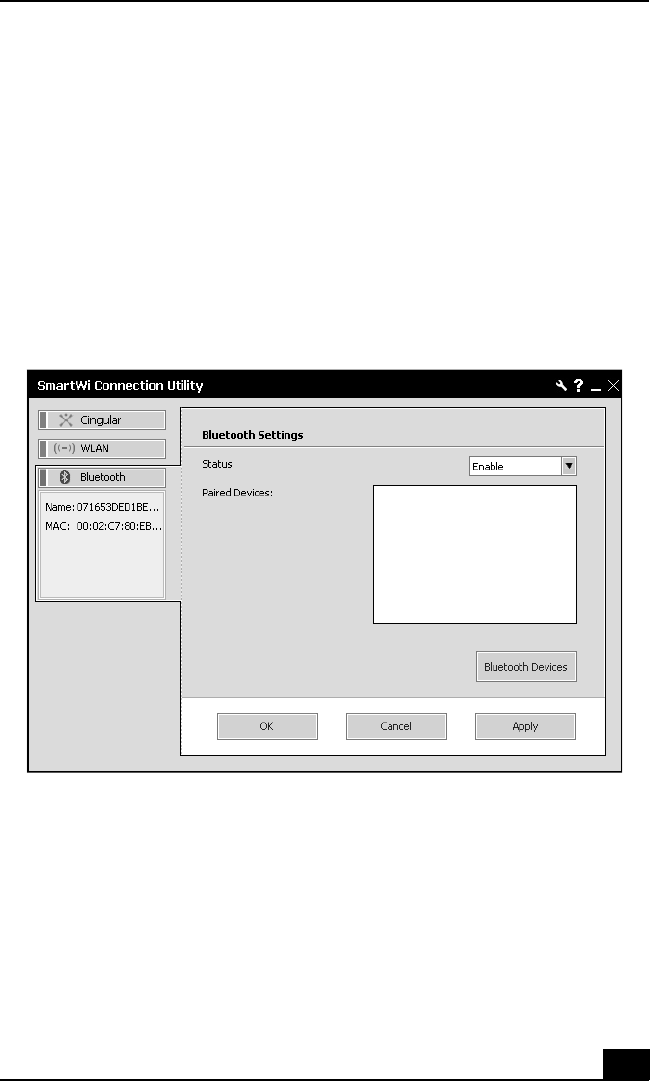
Using the Bluetooth technology connection
21
Using the Bluetooth technology connection
To use Bluetooth® technology connectivity, do the following:
1Click the Bluetooth button on the Wireless Connection Utility dialog box.
This activates Bluetooth® technology, and a status display appears below
the button.
2Next, click the status display below the Bluetooth button. The window
enlarges to display Bluetooth Settings.
3Click the Bluetooth Devices button.
The Bluetooth Settings dialog box displays listing the Bluetooth devices
already configured.
If their are no previous Bluetooth devices configured or you are invoking the
Bluetooth function for the first time, the Add New Connection Wizard
displays for searching Bluetooth devices. Follow the on-screen instructions.
Bluetooth Settings dialog box

VAIO® Computer Wireless Information
22
4From the Bluetooth Settings dialog box, you can select the Bluetooth®
device displayed in the list to view details about the device, reconfigure, or
delete a device previously found.
Click New Connection to start the Add Bluetooth Device Wizard for
searching and locating additional Bluetooth® devices in the vicinity of your
computer. Follow the on-screen instructions.
When completed, click OK.
Bluetooth Settings dialog box

General Functional Information
23
General Functional Information
SmartWi Connection Utility supports the following Wireless WAN-related
functionality:
❑Network Systems
GSM 850, 1800, and 1900
❑Network Services
GPRS/EDGE and SMS
Note: Speech services are not supported
❑SIM Card
Small plug-in card, XX-type with SIM lock
Note: The supplied Cingular SIM card is the only SIM card supported.
❑Speed
Maximum continuous speed and FTP download speeds to 160 kbytes or
more.
❑Interface Type
Internal USB
❑Connection Type
PPP connection across USB
❑Communication Port
Virtual communications on COM port 4

VAIO® Computer Wireless Information
24
Software Upgrades
You can upgrade your PC Card firmware/software from the Internet website
http://esupport.sony.com/EN/VAIO.

FAQ and Troubleshooting
25
FAQ and Troubleshooting
This section provides answers to frequently asked questions (FAQ) and possible
operating workaround information for the SmartWi Connection Utility (SWCU).
In addition, this information can help to clarify issues encountered when using
the SmartWi, Cingular Connection Manager and its associated features.

VAIO® Computer Wireless Information
26
Answers to Frequently Asked Questions
❑General
Question: What is the SmartWi Connection Utility?
Answer: SWCU is a wireless connection utility application that is designed
to switch and manage wireless connection modes between Bluetooth,
802.11, and Cingular GPRS/EDGE.
Question: Can I connect to two separate types of wireless connections
simultaneously (for example, GPRS and 802.11b/g)?
Answer: No. Connections are mutually exclusive, with the exception of
Bluetooth which will run concurrently with other wireless connections.
Bluetooth can be switched on and off via the software without causing
interference to the current connection (for example, GPRS or 802.11b/g).
The hardware indicator/switch for the wireless devices is located at the front
panel on the left side.
❑SWCU Operation
Question: Why do I get a VAIO Assistant prompt when launching WLAN?
Answer: If there is not any WLAN profile configured previously (this is the
first time using WLAN), the VAIO Assistant will be launched automatically,
or the VAIO Wireless Help Utility loads when it detects a failure in
interfacing with the driver. To remedy the problem, follow the suggestions
from the assist help section.
Question: I clicked the “Show All Prompts” button for the Reset all
messages feature, but nothing seemed to happen. What happened when I
clicked this button?
Answer: Clicking the Show All Prompts button for the Reset all messages
feature activates all the prompts (not options) that request the “Don’t ask me
again” action. Normally, when notifications appear from yes/no prompts you
can select if you do not want to be asked again for the notifications by
checking the “Don’t ask me again” check box. The “Reset all messages”
feature provides a way to clear all the checkboxes from all the prompts
simultaneously. As a result, the prompts will display again.
Question: I clicked on the SmartWi minimize option and noticed the
minimized icon was not in the taskbar. Where is the minimized application

Answers to Frequently Asked Questions
27
and how do I bring back the application to the desktop?
Answer: The SmartWi application was minimized into the Task-tray, which
shows the “SWCU” icon and not into the “Taskbar”. Depending on the type
of connection and combination, if any, the SWCU icon will reflect the
current connection. For example, if the SmartWi connects simultaneously
with the Bluetooth device, the icon will reflect the connection type with a
Bluetooth emblem. Switching on and off the Bluetooth option does not
interfere with WiFi or WWAN connection.
To bring forward the SmartWi application to the desktop, click the SmartWi
icon from the task-tray once (see the following illustration) or navigate to
Start --> All Programs --> SmartWi Connection Utility, and then click the
SmartWi Connection Utility icon.
Question: Why do I not have an option to delete WLAN profiles from the
SmartWi WLAN profiles list in the Advanced Settings window?
Answer: Profiles can be managed and edited via SmartWi, but cannot be
deleted. Profiles can be deleted from Windows Wireless Network
Connection Properties or the Intel ProSet Wireless that displays when
clicking Configure WLAN on the SmartWi WLAN Settings dialog box.
Question: I noticed that if I open a WLAN connection from SmartWi,
sometimes the WLAN profile in Windows Wireless Network Connection
window shows “Not connected”, but actually the connection is established.
Answer: Under the Windows Wireless Network Connection window, click
on the “Refresh network list” located under “Network Tasks”. This should
refresh Windows and provide an accurate overview of wireless status. If this
is not fixed the problem, then close the Windows Wireless Network
Connection window and re-launch it from Windows network connections.
❑Cingular Connection Manager (CCM)
Question: What does it mean to “Restore” from the tool help bubble?
Answer: Clicking the “mini bar” option once, reduces the full details to a
Minimized WWAN and Bluetooth connection icon

VAIO® Computer Wireless Information
28
“mini bar”. Click the “Restore” option to return to full details view.
Question: Why does the “Connection Log” not sort when clicking on the
columns title bar?
Answer: This feature will be available in future versions. Sorting by type,
technology, date/time, duration total bytes and description should be
available in future versions.
Question: Why do I see “Device not detected” in the Cingular Connection
Manager details window?
Answer: This is most likely to occur while switching from WWAN to
launching CCM. There is a slight timing degradation that occurs while
making the switch which causes this status. Turn off the WWAN and then
reconnect the WWAN to fix the problem.
Question: CCM sometimes fails to respond after resuming from Suspend
mode. What could be the problem?
Answer: If the “General” tab under the Edit Profile screen for GSM is left
open, this can often keep CCM from reopening upon resuming from suspend
mode. Make certain the “Edit Profile” screen has been closed after making
any changes. A reboot should correct the problem.
Question: When I try to connect through Cingular GPRS network, the
Connect/Disconnect button is greyed out, and there is no connection
available.
Answer: Click on the “Connect Using “tab in CCM, and check one of the
connection types from the drop down menu. Close out of CCM and reboot.
Question: I noticed an option to create a CSD Accelerated/Non-Accelerated
network profile. What is this?
Answer: CSD is Circuit Data Network. This is an older technology with
lower throughput which has been phased out. We recommend that
EDGE/GPRS Acelerated/NonAcelerated profile options be used instead.
❑SMS
Question: What does “Load” do and why does it not prompt for options or
input?
Answer: The SMS help file indicates this is useful in case of accidental
deletion of messages. The “Load” feature would be a way to recover the

Answers to Frequently Asked Questions
29
deleted messages, however, this option provides no notification that the task
completed successfully.
Question: What does “Save” do and why does it not prompt for options or
input?
Answer: The help file indicates this keeps the current state of all folders,
except the inbox. However, no notification is sent indicating the “Save”
completed.
Question: I copied a message to the “Outbox”. Why does it not prompt to
enter the recipient?
Answer: Although you can move or copy a message from one folder to
another, including the “Outbox”, the message must have a recipient before
the message can be sent. If the message is copied and/or moved to the
“Outbox”, the message still will not have a recipient, thus leaving the
message unable to be sent. This would be considered the same as a the
“Forward message” feature. The message would remain in the “Outbox”
indefinitely until a destination or destinations are provided. For working
around this, we recommend double-clicking on the message, enter a
recipient, and then click “Send”.
Question: I created an SMS message, but am not connected to GRPS. How
is it possible that the message can be sent?
Answer: Sending SMS does not need a GPRS data connection. As long as it
detects and attaches to the Cingular network, it will able to send SMS.
Question: What is, and what does the function button “Update Address
Book with Phone Book Contents” do?
Answer: When the SIM is installed, it contains a built-in phone book, which
when using this feature, allows the contents of the phone book to be
incorporated into the address book.
Question: Why I am not alerted of transferring the contents of phone book
to the address book?
Answer: This is a feature that is still under development. A request for
further study to be conducted with this option has been applied.
Question: When I select a message from a folder, and then scroll right, the
all previously existing messages appear to be gone if I scroll back to the

VAIO® Computer Wireless Information
30
original folder position.
Answer: Click out of the folder, and then back in to refresh the screen.
Question: I clicked on the Cingular Connection Manager minimize button
and noticed that the CCM icon was not in the taskbar. Where is the minimize
icon and how do I bring forth the application to the desktop?
Answer: The CCM minimizes into the Task-tray, which is represented by
the “Cingular” trademark cross icon and not into the “Taskbar” (see the
Cingular logo illustration below). Depending on the strength of the GPRS
signal, the trademark will reflect this with a degree of graduations. In other
words, if the signal strength synchronizes to 3 bars (see the Task-tray
illustration below), the Cingular trademark cross will show approximately
half of trademark jackman in the task tray. If the signal strength is one bar,
the trademark jackman will appear to show a bottom portion of the
trademark jackman. If the signal strength is at five bars, the entire Cingular
trademark jackman will be fully indicated.
To bring forth the CCM to the desktop, click the Cingular trademark icon in
the task-tray or right-click the Cingular trademark cross and select “Show”.
❑GPRS Network
Question: Why do I see a network connection speed rate of 214.4 Kbs, but
when I try to access a website that requires a minimum of 128 Kbs, I am told
that I do not have the required minimum rate.
Answer: The network speed indicator provides the capacity of the wireless
device is 214.4 Kbs but the actual speed depends on network throughput. To
work around this, try to change the network settings to optimize the
Cingular logo trademark jackman
Minimized Cingular logo trademark jackman

Answers to Frequently Asked Questions
31
GPRS/EDGE value. This is done by accessing CCM --> Tools -->
Settings… --> Advanced Networking, and then selecting “Optimized
GPRS/EDGE value” option form the RWIN variables window.
Question: I am experiencing dropped connections, slowness, and other
difficulties while attempting to stream video over the Cingular GPRS
connection. What could be the problem?
Answer: Bandwidth over the Cingular GPRS network is somewhat
restricted as compared to wired or 802.11x wireless connection types. Due to
the demanding nature of streaming audio/video, it is not recommended that
GPRS be used for either streaming video, or very large data downloads.
Question: I am experiencing difficulty reconnecting to my web browser
when switching from the Cingular GPRS network to a WLAN connection.
What could be the problem?
Answer: The network behind the WLAN’s Access Point may be set up to
use a proxy server. If this is the case, proxy settings entered for Internet
Explorer over WLAN may prevent IE from connecting over a GPRS link.
To allow web browsing from either connection type:
1Correctly configure IE proxy settings for use over the WLAN
connection. Then, open the Cingular Connection Manager and right-
click the “GSM” tab. Select “profiles” and then click on the “Edit”
button.
2Under the “General” tab, make certain that the “Disable IE’s manual
proxy settings on connect” checkbox has been enabled. Close the “Edit”
screen and then close and reopen Internet Explorer. Remember to close
and reopen IE each time you switch connection types in order to refresh
proxy settings within Internet Explorer.
3If you are still having trouble, contact your network administrator to
assist in obtaining the proxy settings.
Question: I am seeing a message in Windows taskbar stating; “GPRS a
Network Cable is Unplugged”. What does this mean?
Answer: Typically, this message appears if your VAIO PC is connected to
the Cingular GPRS network and is allowed to go into hibernation. Upon
resuming, Cingular has terminated the connection. However, Windows
information has not yet been updated to recognize this change and is
unaware that your GPRS connection does not require a cable. You may

VAIO® Computer Wireless Information
32
either re-connect to Cingular, or simply cancel out of the message.
Question: Downloads sometimes appear to be slow when connecting to the
Internet via CCM. What type of download speeds should I expect?
Answer: Since CCM operates over a cellular network and is subject to the
same issues/conditions as cellular connections, bandwidth may vary greatly.
Common download speeds ranging from 18~64Kbps are possible with
30~36Kbps rates as typical. However, these are only estimates and your
actual experience will likely vary depending upon a number of
environmental factors.
Question: What is meant by “RWIN” from the CCM Tools settings
advanced networking section?
Answer: The TCP Receive Window size is the amount of ‘receive’ data (in
bytes) that can be buffered at one time on a connection. RWIN (TCP Receive
Window) can be changed using the method of setting up the variables to
optimize TCP. We recommend that this setting not be changed unless you are
an expert or you have explicit instructions from your network administrator.
❑Sonic Stage/Music Store
Question: I am unable to stream audio from some web sites such as
Winamp©, Shoutcast©, etc. using Sonic Stage? Why is this the case?
Answer: Many of these web sites use proprietary players and use encoding
formats that are not supported by other players. You can download one of
these players if you wish, or try streaming from Sony Connect™ Music
Store using Sonic Stage.
Question: Sonic stage appears to lock up indefinitely (displays a spinning
‘LOADING’ logo) when attempting selecting “Radio Connect” (streaming)
from Sony Connect™ site.
Answer: This is related to the issue of streaming audio over low bandwidth
connections as referenced above under “GPRS Networking”. Connecting to
Music Store over a wired or broadband connection will usually resolve this
issue.
✍Changing the settings for this value also has an effect when using WLAN
device or any device that depends on TCP connection.

Answers to Frequently Asked Questions
33
❑Bluetooth® technology
Question: Why do I not see the Bluetooth device that is connected to the
computer from the BT Paired Device status box of the SmartWi Connection
Utility?
Answer: It is most likely no Bluetooth devices have been configured for the
system. Bluetooth devices are not configured automatically. To install or
configure Bluetooth devices, you will need assistance in setting up the
Bluetooth device on the computer. Follow steps from the help section
“Installing the Bluetooth device”. We recommend obtaining the latest
Bluetooth drivers.
Question: I can not connect to my Bluetooth keyboard (or other device).
What could be the problem?
Answer: You will need to make certain that you are using the most current
drivers available for your Bluetooth device. Try reinstalling under the
updated driver per the manufacturers instructions.
❑Uninstall, Reinstall and Repair
Question: How do I uninstall the SmartWi application and all its associated
modules?
Answer: There are several components that should be uninstalled when
removing the SmartWi application. The following steps should be observed
while uninstalling the SmartWi application
1Uninstall Cingular Connection Manager
2Uninstall SmartWi connection Utility
Question: How do I reinstall the SmartWi or Cingular connection manager?
Answer: Use the following instructions:
1Click Start in the windows taskbar> Control Panel>VAIO
Recovery>Reinstall Application or drivers
2Click Next>select Wireless Connection Utility> Next
Question: I do not see a repair option for the SmartWi from the control
panel. How do I repair the SmartWi and its associated modules?
Answer: At this time there is no “Repair” option for the SmartWi and
associated modules. To work around this, we recommend to uninstall

VAIO® Computer Wireless Information
34
SmartWi and the associated modules and then reinstall.
Question: If I uninstall and then reinstall the Cingular Connection Manager
application, will the application lose the messages and phone book?
Answer: Uninstalling the Cingular Connection Manager application will not
remove your messages or the phone book. After reinstallation has been
completed, you are prompted to launch CCM and view the readme.html file.
Click OK to launch CCM. Load SMS and advance to messages. Observe
that the messages remain. Load the phone book, and notice that the contacts
remain.

VAIO Homepage
http://www.sony.com/vaiopc
© 2006 Sony Electronics Inc.
For customer support information, go to:
http://www.esupport.sony.com/EN/VAIO